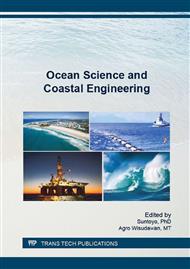[1]
A. Mullai and U. Palusson, A Grounded Theory Model for Analysis of Marine Accidents, Accident Analysis and Prevention. 43 (2011) 1590-1603.
DOI: 10.1016/j.aap.2011.03.022
Google Scholar
[2]
E. Hollnagel, Understanding accidents-from root causes to performance variability, IEEE 7 Human Factors Meeting, Scottsdale Arizona, (2002).
Google Scholar
[3]
P. Underwood and P. Waterson, Accident Analysis Models and Methods: Guidance for Safety Professionals, Loughborough University, United Kingdom, (2013).
Google Scholar
[4]
W. Mutmainnah, and M. Furusho, 4M Overturned Pyramid (MOP) Model: Case studies on Indonesian and Japanese Maritime Traffic Systems (MTS), Proceedings of TransNav 2015, Gdynia (2015) 275-282.
DOI: 10.1201/b18514-43
Google Scholar
[5]
W. Mutmainnah, and M. Furusho, The characteristics of ship collision accidents in United Kingdom analyzed by MOP Model, Proceedings of Asia Navigation Conference 2015, Kitakyushu (2015) 406-411.
Google Scholar
[6]
Japan Coast Guard, A Present situation and provision about marine casualty in 2008, on http: /www. kaiho. mlit. go. jp/info/kouhou/h21/k20090331/k090331-honpen. pdf. (in Japanese).
Google Scholar
[7]
Japan P&I Club, P&I Loss Prevention Bulletin, Vol. 2 in January 2014, on https: /www. piclub. or. jp/lossprevention/guide/?action=common_download_main&upload_id=3452. (in Japanese).
Google Scholar
[8]
Information on http: /jtsb. mlit. go. jp/jtsb/ship/ (in Japanese).
Google Scholar
[9]
Information on http: /www. timeanddate. com/sun/?query=Japan.
Google Scholar
[10]
Information on http: /www. mlit. go. jp/jtsb/marrep. html.
Google Scholar
[11]
M. R. Grech, T. J. Horberry, and T. Koester, Human Factors in the Maritime Domain, CRC Press, France, (2008).
Google Scholar
[12]
M. Furusho, IM Model for Ship Safety, proceedings of inaugural general assembly, Turkey (2000) 26-31.
Google Scholar
[13]
M. Furusho, Disaster of Italian Passenger Ship Costa Concordia – a Nightmare 100 Years after the Titanic-, The Mariners's Digest, 28 (2013) 31-35. (Magazine).
Google Scholar
[14]
A. Nurwahyudi, Contemporary Issus in Domestic Ro-Ro Passenger Ferry Operation in Developing Countries: Identification of safety issues in domestic ferry operation based on accident investigation reports on ferry involved accidents in Indonesian waters, 2003–2013, Thesis Book, World Maritime University, Malmo, (2014).
DOI: 10.3940/rina.roro.1990.06
Google Scholar


